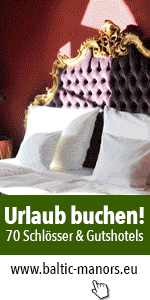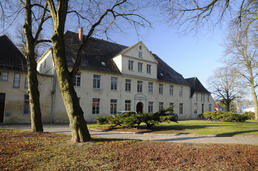Manor House Dummerstorf
The Dummerstorf manor house is one of the oldest manor houses in Mecklenburg-Western Pomerania and is listed under national heritage protection.
It was constructed in Baroque style as an ancestral seat of the Mecklenburg noble family von Preen between 1714 and 1717 and expanded around 1780 with the addition of cavaliers on the western and eastern side of the house. Driven by financial constraints, the von Preen family sold it to the German-American banker, Enrique Gildemeister, who was the former ambassador of Peru in Berlin. Gildemeister invested a lot in modernization of the property during the period after 1910: store, farm worker cabins, court barns, horst stable, cow shed, and barns (both blasted in 1981 to create residential blocks) were built and refurbished.
In 1933, Enrique Gildemeister was forced to sell the property to the Nazi state since he was foreigner. The property thereafter went into the management of the “Reichsumsiedlungsgesellschaft” (German resettlement corporation), a state-owned company who divided land into property parcels then sold them as settlements. Starting in 1939, the German Reich took over the buildings, which had been included as a sample property of the Institute of Animal Breeding of the Kaiser-Wilhelm Association that had been established that year.
During the GDR times, the manor house was the seat of Dummerstorf estate. In addition, the building also housed the municipal council (ground floor), the mayor (upper floor), the housing administration (ground floor), the ABV (right cavalier next to the post office), a reception for services (left cavalier), the Sparkasse, post office, a prison kitchen, apartments for workers, etc.
In the 1990s, a veterinarian also moved into the premises to replace the former reception office. Since 2007, the complex has been in the hands of the current owner, who is renovating it in close cooperation with the office for national heritage protection and in accordance to ecological construction guidelines. In 2009, one apartment was sold to allow for the formation of an owners’ association who use the attic and the parking area jointly. In 2009, the exterior façade and the windows were refurbished according to national heritage protection guidelines. Four apartments in the manor house are currently being used. In addition, the house also has a garden hall that is accessible via a double-wing entrance door located at the center of the house on the northern side facing the park on the southern side. Furthermore, there is a stucco hall on the upper floor. In the future, both halls are set to be used by the occupants for events such as concerts, book readings, presentations, or also made accessible to the public.
Structure of ownership prior 1945:
| before 1506 |
von Preen family |
| (1775)-1803 |
Claus Joachim von Preen (see also Bandelstorf) |
| 1803-1822 |
Chamberlain August Claus von Preen (see also Bandelstorf) |
| 1822-1841 |
Administrative District Officer Rudolf Carl Christoph von Preen |
| 1841-1862 |
Head Forrester Georg Ulrich August von Preen (see Bohmshof) |
| 1862-1863 |
Head Forrester Georg Ulrich August von Preen and Albrecht Friedrich Ludwig Leopold von Preen (see Bohmshof) |
| 1863-1886 |
Albrecht Friedrich Ludwig Leopold von Preen (see Bohmshof) |
| 1886-1906 |
Brothers Georg Victor Theodor Friedrich Emmo Rudolf von Preen and Victor Adolf Ludwig Otto August Friedrich von Preen (see Bohmshof) |
| 1906-1935 |
Enrique Gildemeister (see Bohmshof) |
| 1935-1945 |
German resettlement corporation Berlin |
| -1945 |
Institute of Animal Breeding |


